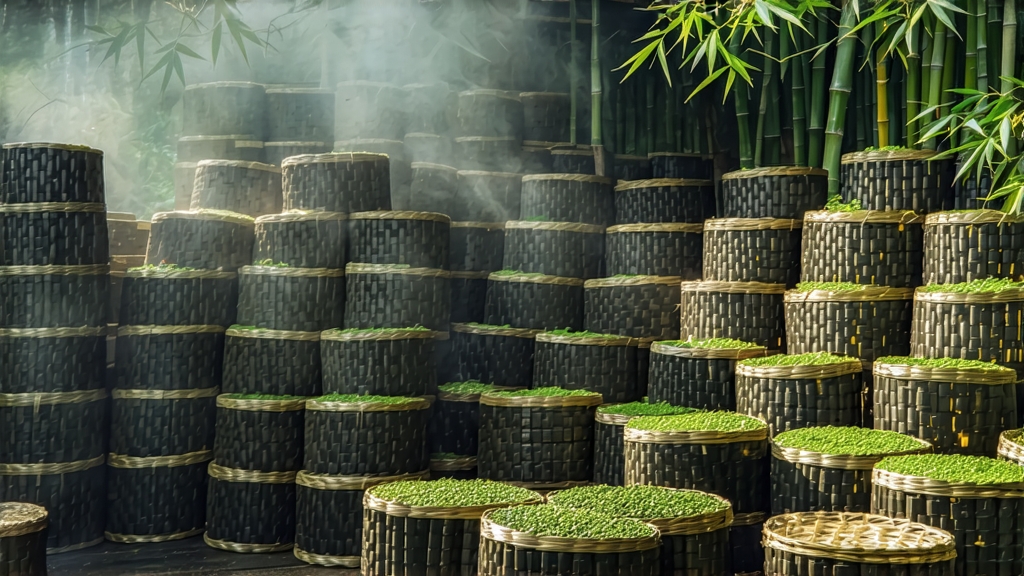
Tucked away in the humid mountains of southern Guangxi, Liu Bao tea has spent four centuries quietly fermenting while its more famous cousins—Pu-erh and Fu brick—stole the international spotlight. Yet for traders of the ancient Tea-Horse Road, Liu Bao was the currency that bought horses in Tibet and cooled the blood of Malay tin miners. Today this glossy, betel-colored tea is experiencing a renaissance among sommeliers who prize its maritime minerality and its ability to taste like the year it was born, or the decade it sailed.
History: From Imperial Tribute to Dockside Staple
The first written record appears in 1620, when the county gazetteer of Cangwu noted “dark tea from Liu Bao village, pressed into baskets, carried by raft to Guangzhou.” By the Qing dynasty the tea had become one of the “Twenty-Four Tributes” shipped to Beijing each spring. Junks then carried it south through the Pearl River delta to Hong Kong, where it was re-loaded onto clippers bound for Singapore and Kuala Lumpur. In the Straits Settlements it acquired the Hokkien name “Liu Pau” and was stacked in the godowns of Clarke Quay, absorbing the camphor and sea-salt air that still perfume older vintages. The British colonial offices served it weak and sweet to cool laborers; the Hakka dock workers drank it thick and black to cut the grease of pork offal. Thus the same leaf existed as both proletarian tonic and imperial luxury, a duality that shapes its identity even now.
Terroir and Leaf Style
Liu Bao is not a single cultivar but a mosaic of Guangxi’s indigenous large-leaf tea trees (Camellia sinensis var. sinensis forma macrophylla) growing between 200–800 m on lateritic red soils. The microclimate—sub-tropical monsoon, 75 % average humidity, frequent hill fog—forces the leaves to grow slowly, accumulating theaflavins and methyl salicylate, the compound responsible for Liu Bao’s signature cooling finish. Farmers pluck one bud with three to four leaves in late April, when the spring rains pause and the leaf’s cuticle thickens, ideal for the strenuous fermentation ahead.
Craft: The Secret of the “Wet Pile” and the Bamboo Basket
Unlike Pu-erh’s wò duī, Liu Bao’s piling is gentler and shorter, yet more intricate. After brief withering the leaves are roasted in a wok at 280 °C for eight minutes, just enough to kill green enzymes while preserving leaf integrity. They are then rolled for 40 minutes on a rattan tray until the cords of leaf become visible like veins on a boxer’s arm. The critical step is “water returning”: the semi-dried leaves are sprayed with mountain spring water, stacked 70 cm high under jute sacks, and left to ferment for 10–15 days. Temperature is never allowed to exceed 55 °C; every 48 hours the pile is turned by barefoot workers who judge readiness by aroma—first like steamed corn, then like damp bark, finally like rain on hot granite. Once the core turns walnut-brown the tea is sun-dried, then steamed and packed into cylindrical bamboo baskets lined with wild banana leaf. These baskets, still woven by the Yao minority, allow micro-oxygenation while the banana leaf donates a faintly floral note. The tea rests in riverside godowns where camphor wood beams exhale slowly, gifting the unmistakable medicinal coolness that aficionados call “gui wei”—cinnamon-ghost.
Aging: The Voyage That Never Ends
A common saying in Wuzhou is “one year is tea, three years is medicine, ten years is antique.” The baskets are stacked cross-wise so air can snake upward, and every two years the lids are opened for “fan cang” (turning the warehouse). During this ritual masters sniff, weigh, and re-steam select baskets to re-activate fermentation. The best lots are moved to the upper floors where summer heat reaches 40 °C, accelerating the Maillard reactions that yield cocoa and molasses tones. After thirty years the leaves shine like black jade and brew into a liquor the color of Château d’Yquem, but clearer, with a meniscus that refracts a cobalt halo.
Grades and Commercial Forms
Liu Bao is sold both loose and compressed. Traditional grades run from top-grade “Special Flag” (te ji) down to “